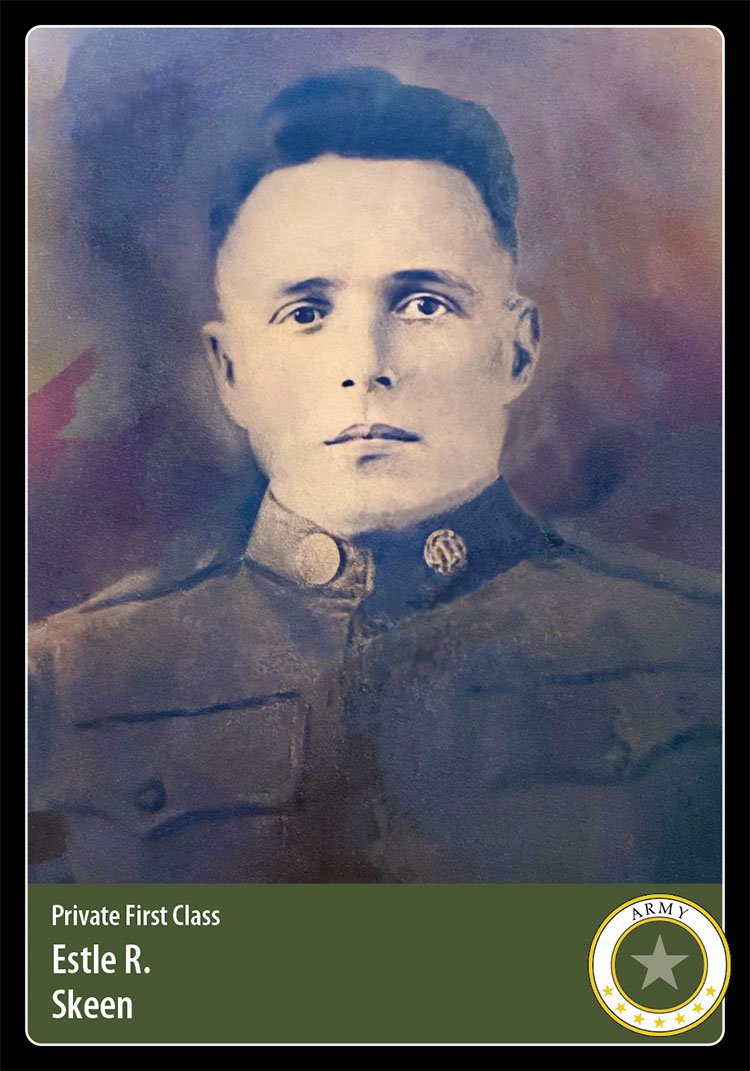Hero Card 211, Card Pack 18
Photo (digitally enhanced) provided by the family.
Hometown: Dandridge, TN
Branch: U.S. Army
Unit: 120th Infantry Regiment, 30th Infantry Division
Military Honors: Purple Heart
Date of Sacrifice: September 29, 1918 - KIA in Bellicourt, Picardy, France
Age: 22
Conflict: World War I, 1914-1918
Near the small Tennessee town of Dandridge, nestled along Douglas Lake in the Smoky Mountains, Estle Ray Skeen was born on November 6, 1895, to parents James and Minty Bell (Barbee) Skeen.
With war raging in Europe, Estle registered for the United States Army on May 29, 1917, at age 21. He listed “Farmer” as his occupation and described himself as tall and slender.
Skeen was assigned to the U.S. Army’s 30th Infantry Division, nicknamed the “Old Hickory Division” in honor of Skeen’s fellow Tennessean Andrew “Old Hickory” Jackson. Jackson became a national hero after leading troops from Tennessee and the Carolinas during the War of 1812 and would later become the 7th President of the United States (1829 to 1837).
Members of the 30th wore a red oval shoulder patch with a blue edge forming the letter O, with an H inside the oval, for “Old Hickory.” Inside the H were the Roman numerals XXX—to reflect the 30th Division.
PFC Estle and his 120th Regiment, 30th Infantry Division were sent to northern France in the fourth year of World War 1 (1914-1918). There they engaged in brutal trench warfare against the Central Powers of Germany, Austria-Hungary, Bulgaria, and the Ottoman Empire.
The Allied Powers—Great Britain, France, Russia, Italy, Romania, Canada, Japan, and the United States—were at last turning the tide against the German army in France. The “Hindenburg Line” near the border of Belgium in northern France was Germany’s last zone of defense on the Western Front.
In the early morning hours of September 29, 1918, near the town of Bellicourt—100 miles northeast of Paris in northern France’s Picardy region—Col. Sidney Minor was commanding PFC Skeen’s 120th Infantry Regiment. Col. Minor captured the anxious first moments of the bloody assault on the Hindenburg Line:
At 4:30 a.m. all troops were [ready] and the slow passing second each seemed an age. At 5:45 we stood with watch in hand. Could the seconds never pass? At 5:49 all was still, a deathly silence. As the final second came, the thunder of all ages seemed to break at once, the earth trembled and the flashes of hundreds of guns in the early dawn gave it all a fearsome aspect.
In an article commemorating the 100th anniversary of the battle, The History Channel describes the 56-hour-long bombardment:
Australian, British, French and American forces participated in the attack on the line, which began with the marathon bombardment, using 1,637 guns along a 10,000-yard-long front. In the last 24 hours the British artillery fired a record 945,052 shells. After capturing the St. Quentin Canal with a creeping barrage of fire—126 shells for each 500 yards of German trench over an eight-hour period—the Allies were able to successfully breach the Hindenburg Line on September 29 [1918].
Private First Class Estle Ray Skeen, age 22, was one of the brave soldiers lost on that day. Because of PFC Skeen and his fellow soldiers swarming from the trenches, the formidable Hindenburg Line was broken. The “war to end all wars” would be over within six weeks, and western Europe liberated.
StarNews Media reports that one member of the Old Hickory division, Thomas Mosette Lee of Clinton, North Carolina, wrote:
They fought like seasoned veterans, like warriors they fell;
They stormed the battlements of death;
They charged the gates of Hell;
And laid the haughty legionnaires of Hindenburg supine;
And the world sang ‘Yankee Doodle,’
when the Yankees broke the line.
PFC Skeen was laid to rest with his fellow soldiers at the Somme American Cemetery in Bony, France (Plot A, Row 24, Grave 3).
Sources
Details submitted by Major General (retired) Leslie Purser and Craig & Connie Kisabeth. Mrs. Kisabeth is PFC Skeen’s great-niece.
East Tennessee Veterans Memorial Association: Estle R. Skeen
Honor States: Estle R Skeen
StarNews Media, Nov. 11, 2018: SUNDAY INSIGHT: Breaking the Hindenburg Line in 1918
History Channel: Allied forces break through the Hindenburg Line
The History Press: Breaking the Hindenburg Line: The capture of St Quentin Canal
Burial Site: Find a Grave





